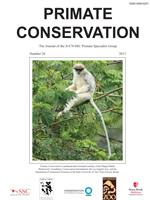The primatology community recently lost one of its most important contributors, taken away by the illness against which she fought for two years. Dr. Annie Gautier-Hion studied central African primates in the field for 35 years. She was best known for her pioneering work on the ecology, evolution and biogeography of guenons, and for a study of western lowland gorillas in Odzala-Kokoua National Park. She contributed greatly to the field of primate evolutionary biology and ecology at the Paimpont Biological Station (University of Rennes), and her work led to the production of over 170 publications.
In 1963, Annie answered an advertisement for a research candidate to study western lowland gorillas posted by Prof. Pierre-Paul Grassé. She travelled to Gabon in 1964 to study 10 captive gorillas, all of them bushmeat orphans. Dr. Jean-Pierre Gautier joined her in 1965, but when a disease outbreak among the animals forced them to give up this study, they decided to switch focus from the largest of primates to the smallest old-world monkey, the talapoin, and were among the first to study the ecology and social structure of this species.
The Gautiers expanded their study to other cercopithecine species living in the Makokou area of northeastern Gabon, and investigated the complex social relationships observed in polyspecific groups. They discovered how the complementarity of ecological niches and anti-predatory strategies could facilitate inter-species associations. Their research was strengthened through the combination of field observations and captive studies when they established a breeding colony of cercopithecines in Gabon where they could closely observe the animals. In 1969, this breeding centre was transferred to the Biological Station of Paimpont for behavioural studies, and still exists.
After meeting Jonathan Kingdon in 1977, Annie oriented her research towards evolutionary biology. Their collaboration led to the 1988 publication of a benchmark volume “A Primate Radiation: Evolutionary Biology of the African Guenons”, co-authored and co-edited by Annie Gautier-Hion, François Bourlière, Jean-Pierre Gautier and Jonathan Kingdon.
In 1989, together with Dr. Marc Colyn, Annie set up a research site in Salonga National Park, Democratic Republic of Congo. Political events brought an end to that project, so Annie established another research station in Gabon, at Makandé. In parallel, she led the ethology research laboratory at the University of Rennes from 1991 to 1999. She also co-authored with Dr. Marc Colyn and Dr. Jean-Pierre Gautier an excellently informative and beautifully illustrated guidebook to central African primates, “Histoire naturelle des primates d'Afrique centrale”, published in 1999.
In 1996, Annie finally returned to her initial subject of research, the western lowland gorilla. She set up a research project in Odzala-Kokoua National Park, Republic of the Congo, and launched demographical and behavioral studies in the MayaNord and Lokoué clearings. After she retired in 2004, she published a popular book on gorillas, organized multiple public conferences and an exhibition on gorilla conservation.
Annie was an outstanding scientist. We will remember her passion for African forests and their primates, and her dedication to their study and protection. Annie will be greatly missed by all who knew her.
I worked with Annie Gautier-Hion in Salonga in what is now the Democratic Republic of Congo, and in the Forêt des Abeilles in Gabon, as well as in her research group in France for several years. She was an absolutely great companion in the field and showed me how to see, hear, and understand the monkey species that we studied. I have many fond memories of (mostly hilarious) incidents with her as well as the many astonishing things we saw together in the African rainforest. She was always fascinated by natural history of all kinds, excited to communicate about wildlife, very sympathetic to and respected by, all her African colleagues, from the trackers to the University professors with whom she collaborated. Much of what we know of the ecology of not only the Central African primates, but also many other mammal species, is still based on the work she initiated at the Mpassa research station near Makokou in Gabon in the 1980s.
I last saw her in her cottage in rural Brittany less than a year before she died. Her enthusiasm for life, learning, and living creatures had not diminished. We went for walks in the gorgeous surrounding countryside, and visited the Paimpont research station one last time. Annie was a force of nature and is greatly missed by all who ever spent time in the forests with her, and by her colleagues in centers of learning worldwide.






